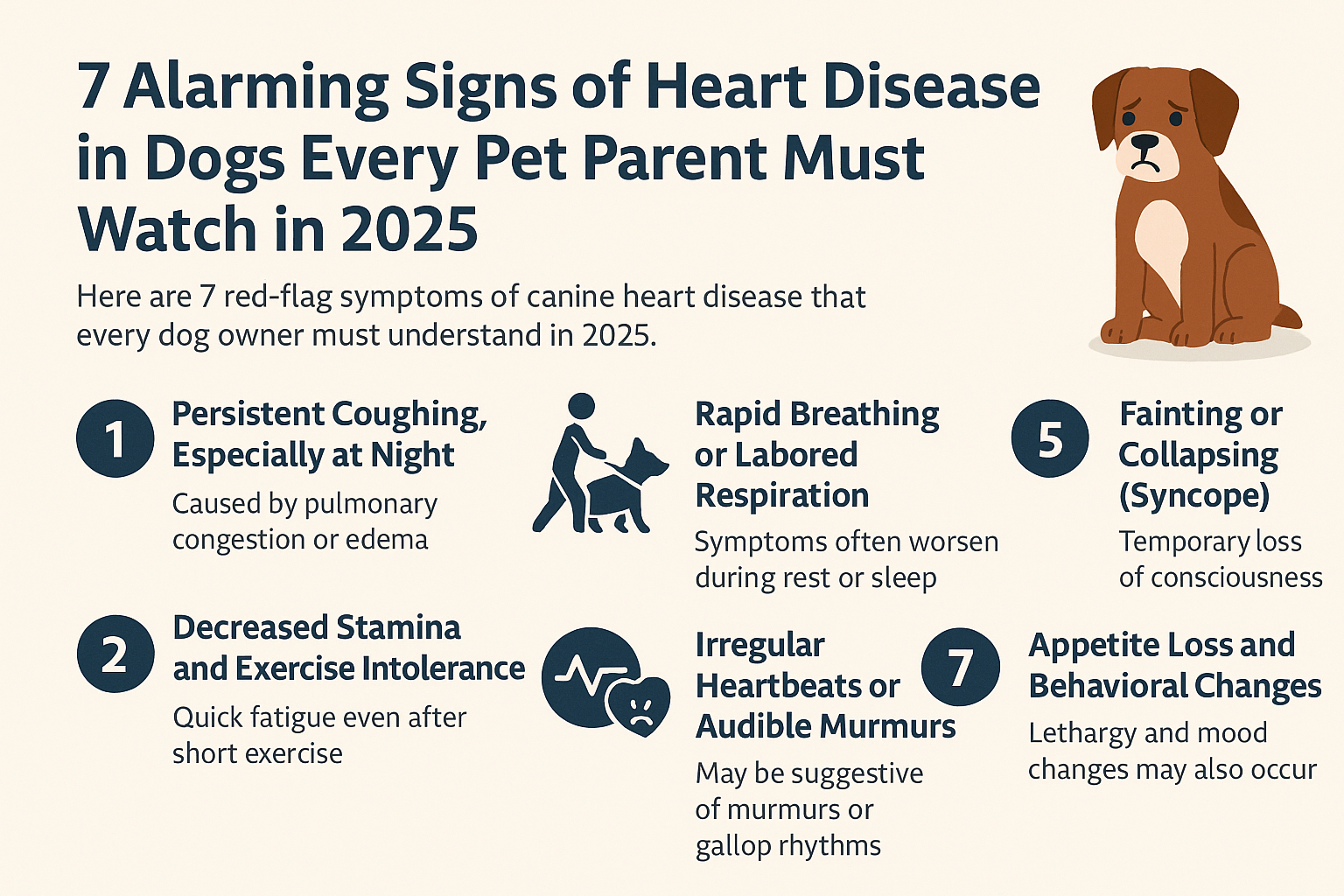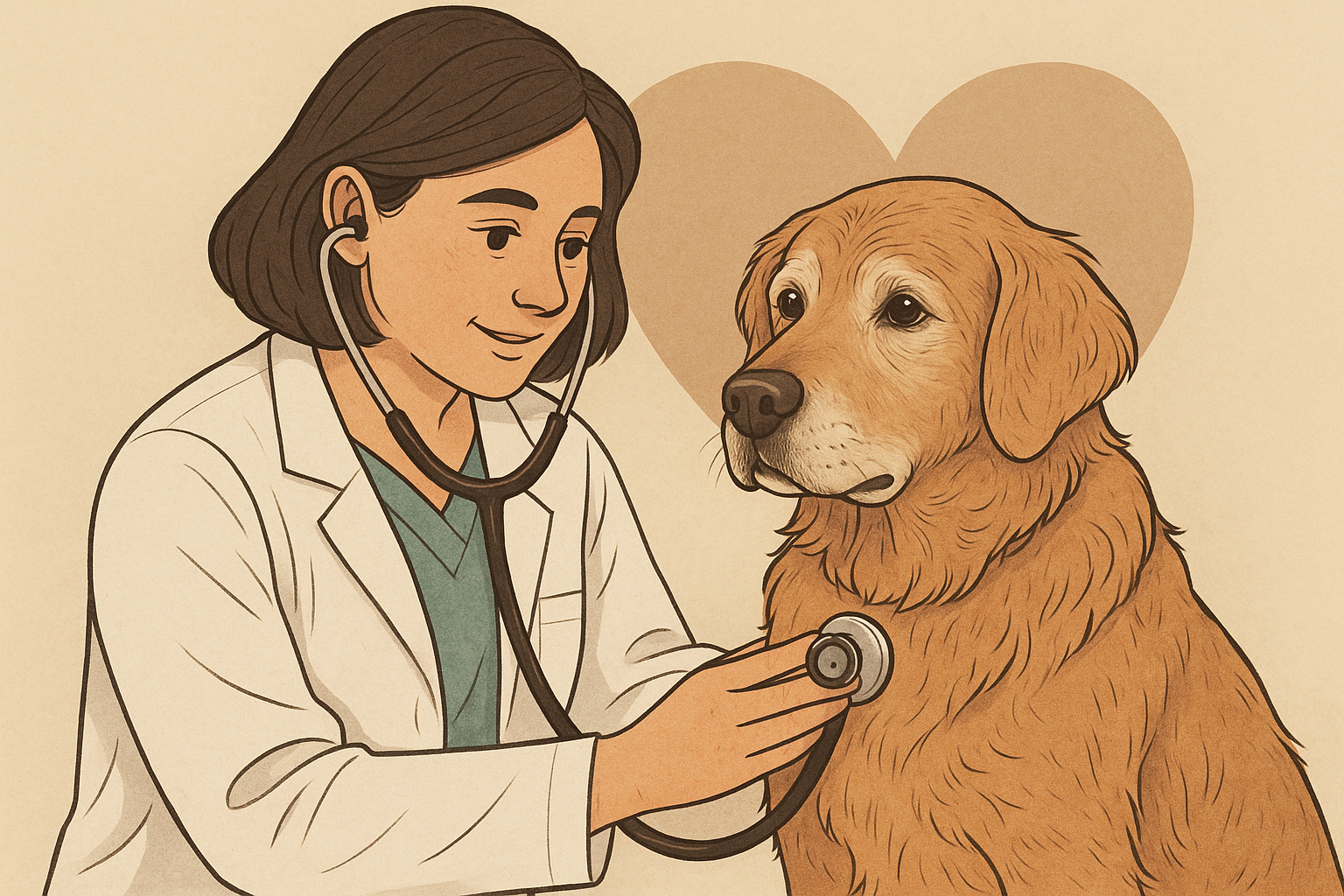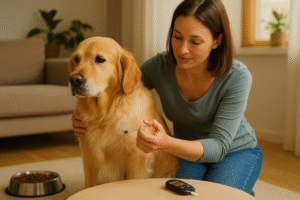It’s easy to miss the early whispers of canine heart disease—a little fatigue on walks, a nighttime cough, or a belly that seems a touch rounder. As a veterinarian, I’ve seen too many pet parents shocked by a sudden diagnosis they never saw coming. That’s why in 2025, we must talk more openly and urgently about canine heart disease.
Canine heart disease is a silent threat, especially in senior dogs. The signs can be easy to dismiss or misread. But with earlier awareness and routine veterinary checks, we can often slow its progression,and give dogs more time with the families who love them.
This article will walk you through seven of the most important signs to watch for in 2025, based on the latest research and what I’ve seen in real-life practice.
Table of Contents
✅ Key Takeaways
- Canine heart disease is a leading cause of death in older dogs, often going unnoticed until advanced stages.
- Common early signs include coughing at night, reduced stamina, rapid breathing, abdominal bloating, fainting, irregular heartbeats, and appetite loss.
- Dogs over age 7,especially small breeds (for CDVD) and large breeds (for DCM),should receive annual heart screenings.
- Early diagnosis through auscultation, X-rays, ECGs, and echocardiography can significantly improve treatment outcomes.
- Treatment in 2025 often includes medications like Pimobendan, ACE inhibitors, and diuretics,tailored to the dog’s specific heart condition.
- Proactive monitoring at home, including respiratory rate tracking and behavior changes, can catch warning signs early.
What Is Canine Heart Disease?
Canine heart disease refers to a range of conditions that impair the heart’s ability to pump blood effectively. It can affect dogs of any age but is especially common in seniors. While some heart problems are present at birth (congenital), most develop over time (acquired).
Common Types in Dogs
1. Chronic Degenerative Valvular Disease (CDVD):
The most common form of canine heart disease, especially in small breeds. It typically affects the mitral valve, causing blood to leak backward into the left atrium.
2. Dilated Cardiomyopathy (DCM):
Seen more often in large and giant breeds like Dobermans, Boxers, and Great Danes. The heart muscle becomes thin and weak, reducing cardiac output.
3. Sick Sinus Syndrome (SSS):
An electrical conduction disorder of the heart, usually in elderly dogs and breeds like Miniature Schnauzers or Westies.
4. Myocardial Hypertrophy:
Thickening of the heart muscle, often secondary to conditions like Cushing’s disease or high blood pressure.
5. Cardiac Tumours:
Rare but serious, tumours such as hemangiosarcoma can cause bleeding or compress the heart, leading to tamponade.

How It Progresses Over Time
Heart disease in dogs usually progresses gradually. Early signs may be subtle or mistaken for normal aging. Without treatment, it can lead to congestive heart failure (CHF), where fluid builds up in the lungs or abdomen. Timely veterinary intervention can help manage the condition and improve quality of life.
7 Warning Signs to Watch For
Understanding the signs of canine heart disease can help you act before symptoms become life-threatening. Below are the seven most common red flags I see in practice.
1. Persistent Night Coughing
A dry, hacking cough,especially one that worsens at night or after rest,can indicate fluid buildup in the lungs due to mitral valve leakage. It’s often mistaken for kennel cough or collapsing trachea. Thomas et al., 2009
2. Fatigue or Exercise Intolerance
Dogs with heart disease may tire quickly on walks, slow down during play, or seem disinterested in activities they once enjoyed. This is especially concerning in breeds prone to DCM or CDVD.
3. Laboured or Rapid Breathing
If your dog’s breathing seems faster or more effortful, especially when resting, it could signal pulmonary edema from congestive heart failure. A resting respiratory rate over 30 breaths per minute is worth flagging.
4. Abdominal Bloating or Ascites
Right-sided heart failure can cause fluid to accumulate in the abdomen. You might notice a pot-bellied appearance or sudden weight gain without increased appetite.
5. Fainting or Collapse (Syncope)
Brief loss of consciousness,often during excitement or exertion,can result from arrhythmias or poor blood flow to the brain. It’s more common in dogs with DCM or SSS.
6. Irregular Heartbeats or Murmurs
A veterinary exam may reveal a heart murmur or abnormal rhythm. Some dogs with murmurs appear healthy, but regular monitoring is essential to catch deterioration.
7. Appetite and Behaviour Changes
Subtle signs like reduced appetite, hiding, irritability, or general listlessness can be early indicators of decreased oxygen delivery and fatigue from heart dysfunction.
How Vets Diagnose Heart Disease in Dogs
If your dog is showing signs of canine heart disease, your veterinarian will use several tools to evaluate their heart function and determine the underlying cause.
What Exams and Tests to Expect
- Physical Examination: Listening with a stethoscope to detect murmurs, gallop rhythms, or irregular beats.
- Thoracic X-rays: Useful to evaluate heart size and detect fluid in the lungs or abdomen.
- Echocardiogram (Heart Ultrasound): Provides detailed images of heart structure, valve function, and chamber size.
- Electrocardiogram (ECG): Detects electrical abnormalities, arrhythmias, and conduction disturbances.
- Blood Tests & Biomarkers (e.g., NT-proBNP): Assess for cardiac stress or concurrent conditions like kidney disease.

These tools are often used together for an accurate diagnosis. For example, a murmur found on exam may be followed by an echo to determine if it’s due to mild valve thickening or severe regurgitation.
Costs of Common Diagnostics in Canada
| Diagnostic Test | Typical Cost (CAD) |
| Physical exam + auscultation | $75–$120 |
| Thoracic radiographs (2 views) | $150–$250 |
| Echocardiography (specialist) | $400–$700 |
| Electrocardiogram (ECG) | $100–$200 |
| NT-proBNP blood test | $120–$180 |
Prices can vary depending on your region and whether a specialist is involved. Always ask your vet about packages or referral options if cost is a concern.
Treatment Options for 2025
Thanks to advances in veterinary cardiology, canine heart disease is more manageable than ever,especially when detected early. Treatment is tailored to the underlying condition and the severity of symptoms.
Medications for CDVD and CHF
Most dogs with chronic degenerative valvular disease (CDVD) and congestive heart failure (CHF) benefit from a combination of the following:
- Pimobendan (Vetmedin): Enhances heart contractility and reduces workload.
- ACE Inhibitors (e.g., Enalapril, Benazepril): Reduce blood pressure and slow disease progression.
- Diuretics (e.g., Furosemide): Remove excess fluid from lungs and abdomen.
- Spironolactone: A potassium-sparing diuretic that supports long-term control of fluid retention.
DCM-Specific Therapies
Dogs with dilated cardiomyopathy may also require:
- Anti-arrhythmic medications such as sotalol or mexiletine.
- Taurine supplementation for certain breeds (e.g., American Cocker Spaniels) with taurine-responsive DCM.
- Specialized diets designed for cardiac support, often low in sodium and enriched with omega-3 fatty acids.
Devices and Procedures
In advanced or specific cases:
- Pacemaker Implantation: Indicated for dogs with Sick Sinus Syndrome or severe bradycardia.
- Pericardiocentesis or Pericardiectomy: Used to manage pericardial effusion or cardiac tamponade due to tumours.

Typical Treatment Costs in Canada
| Treatment | Estimated Cost (CAD) |
| Monthly heart meds (mild/moderate CHF) | $100–$200 |
| Emergency CHF hospitalization | $800–$1,500 |
| Echocardiogram follow-up (annual) | $400–$700 |
| Pacemaker implantation (specialist) | $2,500–$4,000 |
| Pericardiectomy (referral surgery) | $3,000–$5,000 |
Veterinary cardiac care can be an investment, but many owners find that treatment significantly extends and improves their dog’s quality of life.
How to Prevent or Delay Heart Disease
While not all forms of canine heart disease can be prevented, early detection and smart lifestyle choices can make a huge difference,especially for at-risk breeds.
🕔 5-Minute Home Checklist
Use this simple checklist monthly, especially for senior dogs:
- Is your dog coughing more than usual,especially at night?
- Do they seem more tired on walks or playtime?
- Is their breathing faster or more laboured at rest?
- Do you notice any abdominal swelling?
- Are they eating less or acting withdrawn?
- Have you counted their sleeping respiratory rate (>30/min = red flag)?
If you check even one box, schedule a veterinary exam.
Breed-Specific Tips
- Small breeds (e.g., Cavalier King Charles Spaniels, Dachshunds): Screen for CDVD yearly starting at age 6–7.
- Large breeds (e.g., Dobermans, Boxers, Great Danes): Ask your vet about screening for DCM, even if asymptomatic.
- Brachycephalic breeds: Watch for overlapping signs with respiratory disease,diagnosis can be trickier.
Diet & Lifestyle Adjustments
- Choose low-sodium diets designed for heart health.
- Avoid strenuous exercise if your dog is symptomatic.
- Maintain a healthy body weight to reduce cardiac strain.
- Include omega-3 fatty acids or supplements if recommended.
These steps won’t stop heart disease in every case, but they may delay its progression and improve your dog’s overall wellness.
FAQs About Canine Heart Disease
Can heart disease in dogs be cured?
No, most forms of canine heart disease are not curable, but they are manageable. With the right treatment and regular monitoring, many dogs live comfortably for months or even years after diagnosis.
Is coughing always a heart problem in dogs?
Not necessarily. Coughing can be caused by tracheal collapse, bronchitis, or kennel cough. However, a persistent nighttime cough,especially in small-breed seniors,may point to heart disease and should be evaluated.
How long can a dog live with heart disease?
It varies by type and when it’s diagnosed. With medications and proper care, dogs with CDVD or early DCM may live 1–3 years post-diagnosis. Advanced cases, especially with CHF, have a shorter outlook but can still enjoy good quality of life with treatment.
Should I limit exercise for a dog with heart disease?
Moderate, low-stress activity is often beneficial. Avoid strenuous play, especially if your dog tires easily or shows signs of distress. Always ask your vet for tailored activity guidelines.
What’s the first test if I suspect a problem?
A physical exam with auscultation is the first step. If your vet hears a murmur or abnormal rhythm, they’ll likely recommend X-rays, ECG, or an echocardiogram for confirmation.
Can young dogs get heart disease too?
Yes, although it’s less common. Some young dogs are born with congenital heart defects or may develop conditions like arrhythmias early in life. If you’re concerned, especially with high-risk breeds, ask your vet about early screening.
Final Thoughts: Advocate for Your Dog’s Heart Health
Canine heart disease doesn’t always shout,it whispers. The earlier you catch those quiet signs, the more options your vet has to intervene. Whether it’s a subtle cough, momentary collapse, or just something that “feels off,” your vigilance as a pet parent matters more than you might think.
I’ve seen dogs go from struggling to playful again thanks to timely diagnosis and treatment. If there’s one takeaway from this guide, it’s this: don’t wait until symptoms are severe. Annual checkups, asking about murmurs, and trusting your instincts can change the course of your dog’s life.
In 2025, veterinary medicine offers more tools than ever to fight back against canine heart disease,but awareness starts with you.





Pingback: Canine Heart Murmurs